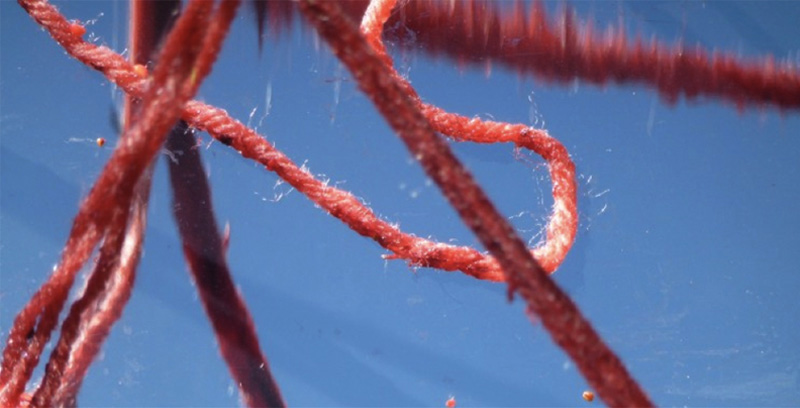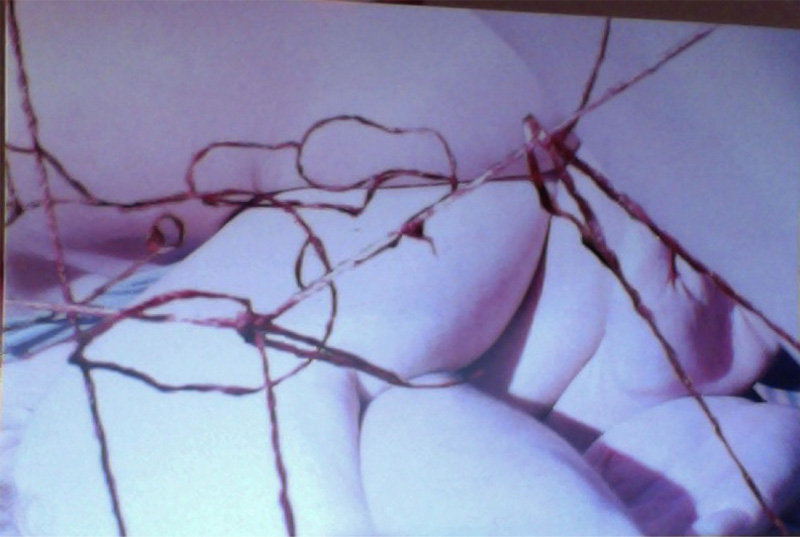In reality there is no one rhythm of duration; it is possible to imagine many different rhythms which, slower or faster, measure the degree of tension and relaxation of different kinds of consciousness and thereby fix their respective places in the scale of being. To conceive of durations of different tensions is perhaps both difficult and strange to our mind, because we have acquired the useful habit of substituting for the true duration, lived by consciousness, an homogeneous and independent Time; however in the first place, it is easy as we have shown, to detect the illusion which renders such a thought foreign to us, and, secondly, this idea has in its favour, at bottom, the tacit agreement of our consciousness. (Bergson, 1991, 207)
I

Under and over and pull it through, under and over and pull it through, under and over and pull it through. Yarn fold into a first loop, a second loop, a third loop; a knot – and again. These movements are the movements of crocheting, at a first glance apparently repetitive and straightforward. But the process is a much more complex one: In these movements of the hook and the yarn a “multi-dimensional surface” (Manning 2012: 6 [manuscript]) emerges, that is made of knots and loops, some of them stable, some of them just on the edge to disappear again.
In the week of Into the Midst there were several of these crocheting events. And there were several points of starting them. We not only began to make new figures out of different yarn, at different places and different situations, also there was not one beginning leading to one knottedstructure. The starting points were multiple and not limited to the beginning of the yarn. The crocheting started in the midst. And – certainly related to this –: it also did not emerge as a repetitive and even pattern. Again and again some of the knots loosened, some stiches opened up or disappeared. Other knots were lashed or crocheted together (but not in a planned or regular way); the stiches were taken up transferred and transformed into other knots and new possible beginnings to start again. What emerged in these collective processes was a structure of manifold knots and loops, some of them tight and strong, others loose and fragile almost on the verge of becoming undone.
What fascinated me most was the emergence of the various loops. Droopy and floppy they were hanging down, separated by the knots from the tensions of the web. At a first glance they seamed to be left over, but they were neither “too much” nor “unnecessary”. They break up the intertwining net of tensions, which was stretching through the park, the Dome or the SenseLab. With these loops the web of knots became more than a bundle of tensions, it became a rhythm full of tension and relaxation: when the tension was ‘too’ much, when the knot set tight, a loop emerged, the tension folded back into itself and let a part of the yarn become floppy. In the knot the tension and relaxation met. Crocheting the yarn: the rhythm of tension and release.
These floppy loops were not only an essential part of the web and the knots, they also made new connections and new linkages possible, they were “[dimensionalizing] landing sites” (Arakawa and Gins 2002) for other knots and new crocheting processes1. The floppy loop of yarn became the potential for knots to connect and produce new tensions and therefore transform the web and extend it in multiple directions. In the crocheting tension and relaxation folded into each other and with them the realms of their mutual virtuality: In the knots and loops the different ways of relaxation are virtually in the tension of the yarn as well as the tension is virtually in the state of relaxation. In the sloppy loops between the tight yarn new knots and new relations become possible, they open up the web for a beginning in the midst. The knot became attentive for the movement of the yarn forming a loop to relate/to land on it.
II

Three times we started crocheting a web in the midst. What has been generated was not a static structure of knots; it was a process, a rhythm of tension and release. The people involved were not so much executing this process as they were themselves part of it. Mostly the crochet hook was just the beginning of the involvement with the yarn, by and by the hooks were replaced by fingers, arms, and other parts of the body. It was not only the yarn, that was knotted to a multidimensional web, the bodies became part of it. They were stretched and scrunched, one could even say, they were full of knots themselves (These knots are in no way comparable or even referring to the deadly knots of cancer, the knots of crocheting are like bundles of intensities moving in a rhythmic pattern with the fields of relaxation). These bodies, us, were neither outside nor prior to the rhythms of crocheting.
In this web of yarn and bodies, movements and knots, the tensions of the strings intermingled with the attention of the participants. Attention is understood here – like tension – as an intensity of relation and neither starting from the subject or the object but is the movement of the bodies and the yarn. No attention for the tension but attention as the event of occurring tensions itself. In his chapter on “Attention and tension” Bergson used the concept of attention to describe not only a merely psychic phenomenon but a movement. “Attention is not a purly physiological phenomenon, but we cannot deny that it is accompanied by movements. These movements are neither the cause nor the result of the phenomenon; they are part of it, the express it in terms of space, as Ribot has so remarkably proved” (Bergson 1910: 27). By following the studies of Ribot and Fechner, Bergson describes the attention as a psychic and muscular movement, correlated with the different sense organs by the rhythm of tension and contraction. Attention is therefor neither reducible to the mind, nor to the subject, it is the attention of the field and of the event. Manning calls it the dance of attention: “the dance of attention is the attentiveness of the milieu itself to the complex landings of experience in the making” (Manning 2013: 139).
Not only the human, but the whole process moves by the rhythms of attention. The web of tension and attention, of muscle and yarn, loops and hands, landing sites and relations evolved and altered during Into the Midst. The sloppy loops, the moments of relaxation made the very specific rhythm not only of the crocheting structure as well as of the event. Like the yarn, the attention – of the participants and of the event – was rhythmic: There was no end, where everyone’s attention was targeted at, there was no need to stay focused all the time on one particular spot. As in the process of crocheting, relaxation was crucial in the attention of the participants. It was the opening up the awareness, the production of landing site in the moments of loosening the event’s tension, which made it so special.
III

Into the Midst was – and definitely still is – a rhythmic event. It was an event of knots: tensions coming together, folding into each other, and tighten the yarn. Like in the process of crocheting, the moments of the strongest tension produced the parts of yarn, which were totally sloppy and relaxed. Relaxation not understood as the opposite of tension but as its very excess: no dichotomy but the rhythm of folding. The knot did not only fold the manifold tensions of the yarn into each other, it also unfolded a moment or a field of relaxation. Like the web of knots, Into the Midst was brimming with these microstructures of tension and relaxation: the manifold processes of (micro-)collaboration, the interferences of diverse practices, images, movements, and concepts as well as the frictional relationship between these practices and the architectural structures of the places the event took place in. All these different aspects did not ‘fit’ together in a way as the knots of the crocheting did not ‘fit’ together to build a ‘proper’ (even and regular) structure. Only by pulling in many different directions the knots emerged in multiple forms and with them the various sloppy loops. In these processes landing sites opened up, shifting the attention and making new connections possible. In the rhythm of crocheting the yarn and the event new practices and processes emerged like knots: always in the midst.
Notes
[1] Awakara and Gins concept of the “landing site” was central for Into the Midst. The idea of the loop as a landing site refers especially to the concept of the dimensionalizing landing site. “A dimensionalizing landing site lands simultaneously narrowly and tightly and widely and diffusely, combining the qualities of a perceptual landing site with those of an imaging one, coupling and coordinating direct responses with indirect ones, the formed with the formless. Attaching a grappeling hook of a perceptual landing site to a vaguely sketched-in rope of an imaging landing site, a dimensionalizing landing site, in landing, hooks onto the environment to gain traction on it. With the hook-and-rope ensemble flung out and an availing surface caught hold of, there comes to be an as-if-trugging-back-to-the-body that conveys a sense of (kinaesthetic) depth” (Awakara and Gins, 2002, 8).
Bibliographie
– Arakawa et Madeline Gins, Architectual Body, Tuscaloosa, University Press, 2002, 128 p.
– Bergson, Henri, Time and Free Will. An Essay on the Immediate Data of Consciousness, Londres, George Allen & Unwin Ltd, 1910, 292 p.
– Bergson, Henri, Matter and Memory, New York, Zone Books, 1991, 101 p.
– Manning, Erin, Dancing the Constraint, Manuscript, 2012.
– Manning, Erin, Always More Than One. Individuation’s Dance, Londres, Durham and London, 2013, 324 p.
